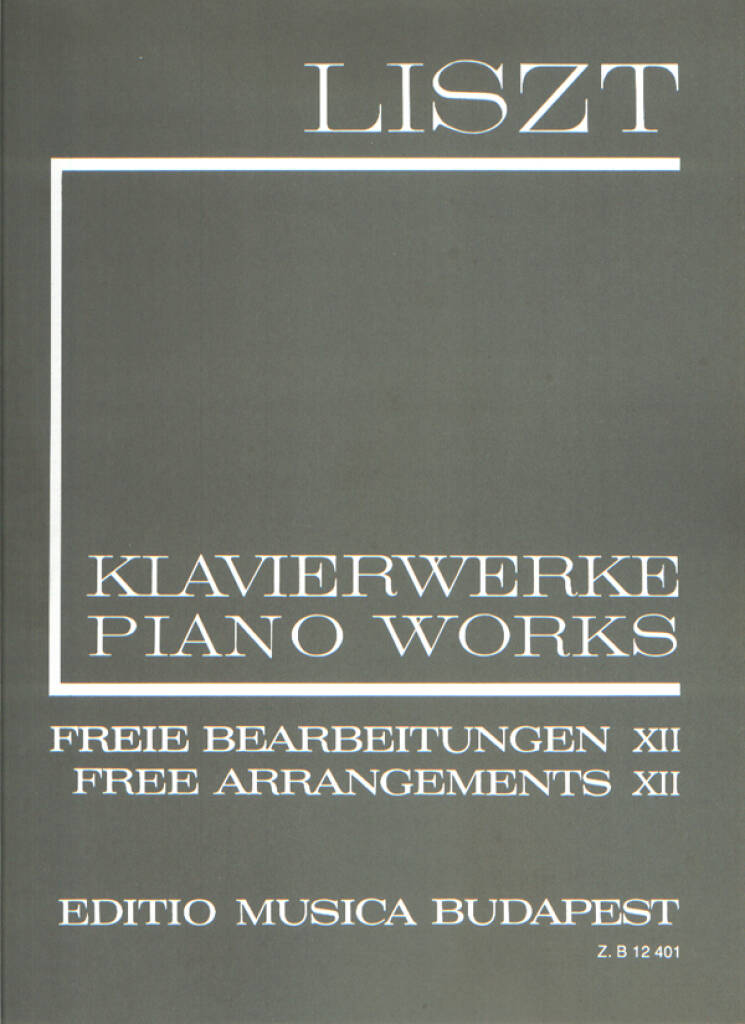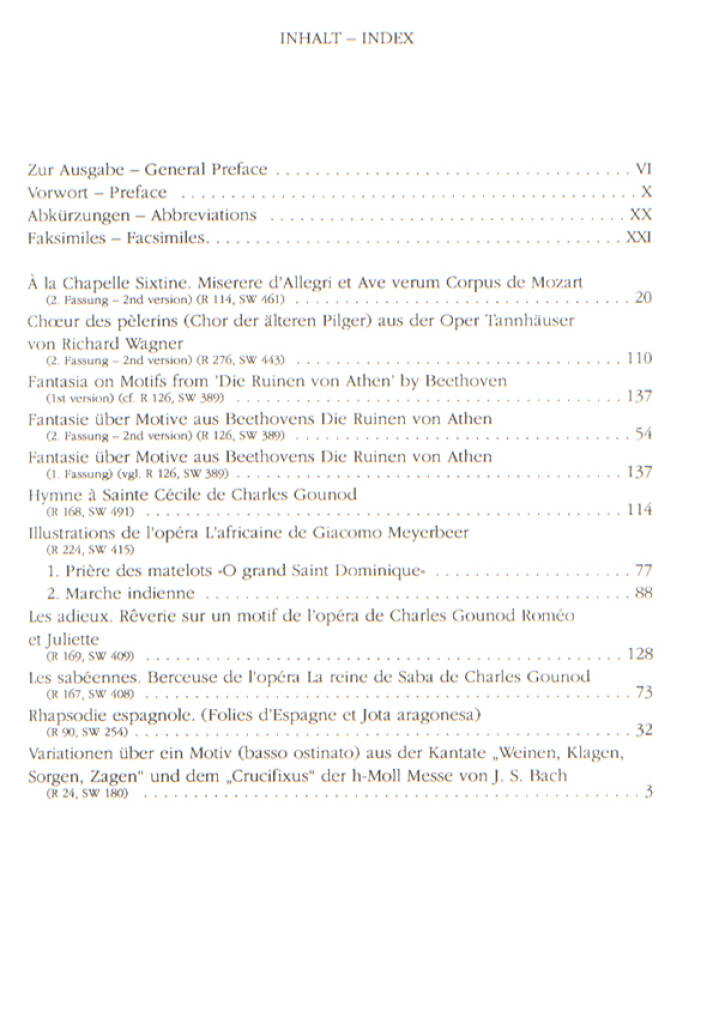Liszt: Free Arrangements and Transcriptions - Volume 12
In stock and typically ships within 1 business day.
- Composer: Franz Liszt (1811-1886)
- Editors: Imre Mezö, Imre Sulyok
- Instrumentation (this edition): Piano
- Originally for: Piano
- ISMN:
- Size: 9.0 x 12.0 inches
- Pages: 172
Description
The volume includes the famous Weinen, Klagen variations, based on Bach's similarly-titled cantata and motifs from the Crucifixus of his in B Minor Mass; a paraphrase of Gounod's Hymne a Ste Cécile , appearing here for the first time in print, A la Chapelle Sixtine , based on Allegri's Miserere and Mozart's Ave verum Corpus (the part based on a chorus from the Ave verum Corpus can also be performed separately), the Rapsodie espagnole , a fantasia on themes from the incidental music to Beethoven's Die Ruinen von Athen , Liszt's transcription of the Pilgrims' Chorus from Richard Wagner's opera Tannhäuser , and Les adieux. Reverie sur un motif de l'opéra Roméo et Juliette. The volume is available linen-bound (with critical notes, Z. 12401A) and also in a cheaper, hard paperbound version that is adequate for practical purposes.
Works marked by an asterisk in the Contents are published here for the first time in print.
Contents
- Variationen über ein Motiv (basso ostinato) aus der Kantate 'Weinen, Klagen, Sorgen, Zagen' and dem 'Crucifixus' ...
- A la Chapelle Sixtine. Miserere d'Allegri et Ave verum Corpus de Mozart (Ave verum Corpus séparé) (2nd version)
- Rhapsodie espagnole. (Folies d'Espagne et Jota aragonesa)
- Fantasie über Motive aus Beethovens Die Ruinen von Athen (2nd version)
- Les Sabéennes. Berceuse de l'opéra La reine de Saba de Charles Gounod
- Illustrations de l'opéra L'africaine de Giacomo Meyerbeer 1. Priere des matelots 'O grand Saint Dominique'
- Illustrations de l'opéra L'africaine de Giacomo Meyerbeer 2. Marche indienne
- Choeur des pélerins (Chor der älteren Pilger) aus der Oper Tannhäuser von Richard Wagner (2nd version)
- Hymne a Sainte Cécile de Charles Gounod *
- Les adieux. Réverie sur un motif de l'opéra de Charles Gounod: Roméo et Juliette
- Fantasie über Motive aus Beethovens Die Ruinen von Athen (1st version )
Works:
- Variationen über das Motiv von Bach, S. 180, LW A214
- À la Chapelle Sixtine - 2nd Version ((Miserere d'Allegri et Ave verum Corpus de Mozart)), S. 461ii, LW A217
- Ave verum Corpus de Mozart, S. 461a
- Rhapsodie espagnole, S. 254
- Fantasie über Motive aus Beethovens Ruinen von Athen - 2nd Version, S. 389, LW A177
- Les Sabéennes (Berceuse de l'opéra La reine de Saba), S. 408, LW A231
- Illustrations de l'opéra L'Africaine (Based on themes by Giacomo Meyerbeer), S. 415, LW A230
- Pilgerchor aus Tannhäuser - 2nd Version (based on the chorus "Heil! Heil! Der Gnade Wunder Heil!" by Wagner), S. 443i, LW A210a
- Hymne á Sainte Cécile de Charles Gounod, S. 491, LW A235
- Les adieux (Rêverie sur un motif de l'opéra Roméo et Juliette), S. 409, LW A237
Publishers use a lot of words to describe what they sell, and we know it can be confusing. We've tried to be as clear as possible to make sure you get exactly what you are looking for. Below are descriptions of the terms that we use to describe the various formats that music often comes in.
Choral Score
A score for vocalists that only contains the vocal lines. The instrumental parts are not there for reference. Generally, cheaper than a vocal score and requires multiple copies for purchase.
Facsimile
Reproductions of the original hand-written scores from the composer.
Full Score
For ensemble music, this indicates that the edition contains all parts on a single system (there are not separate parts for each player). In larger ensembles, this is for the conductor.
Hardcover
Hardbound. Generally either linen-covered or half-leather.
Orchestral Parts
Similar to a wind set, this is a collection of parts. In the case of strings, the numbers listed are the number of copies included, though generally these are available individually (often with minimum quantities required).
Paperback
When publishers offer multiple bindings (e.g. hardcover) or study scores, this is the "standard" version. If you're planning to play the music, this is probably what you want.
Performance / Playing Score
A score of the music containing all parts on one system, intended for players to share. There are not separate parts for each player.
Set of Parts
For ensemble music, this indicates that there are separate individual parts for each player.
Solo Part with Piano Reduction
For solo pieces with orchestra, this is a version that contains a piano reduction of the orchestra parts. For piano pieces, two copies are typically needed for performance.
Study Score
A small (think choral size) copy of the complete score meant for studying, and not playing. They make great add-ons when learning concertos and small chamber works.
Vocal Score
A score prepared for vocalists that includes the piano/organ part or a reduction of the instrumental parts.
Wind Set
For orchestral music, this is a collection of wind and percussion parts. The specific quantities of each instrument are notated.
With Audio
In addition to the printed music, the edition contains recordings of the pieces. This may be an included CD, or access to files on the internet.
With / Without Fingering (Markings)
Some publishers prepare two copies - a pure Urtext edition that includes no fingering (or bowing) suggestions and a lightly edited version that includes a minimal number of editorial markings.





